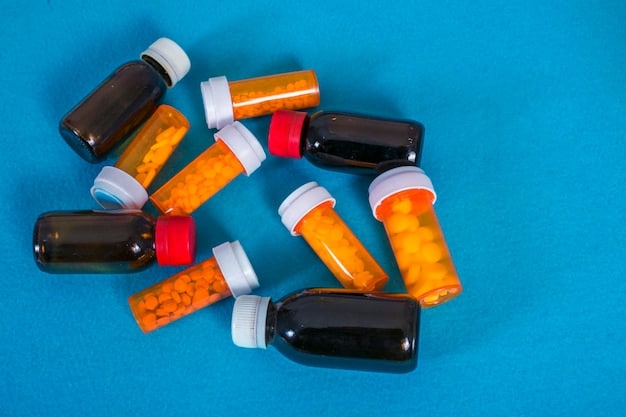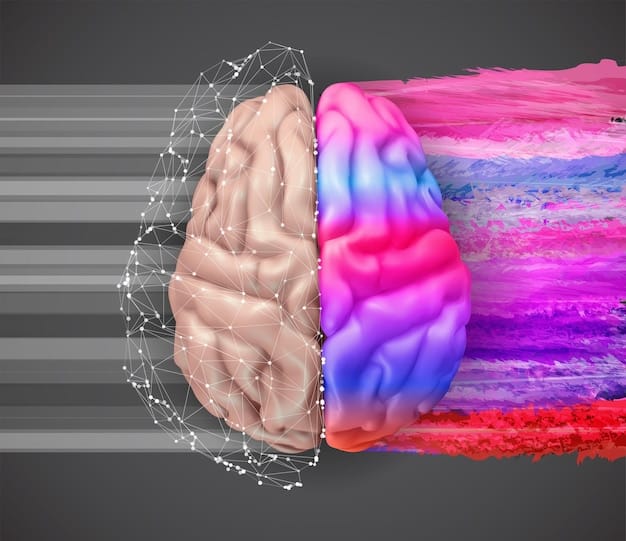Medication-Assisted Treatment: Innovations in 2025 and Recovery Boost

Medication-Assisted Treatment (MAT) is set to evolve significantly by 2025, with innovations in drug formulations, personalized treatment plans, and integration with digital health tools, projected to improve addiction recovery rates by up to 15% through more effective and accessible care.
Medication-Assisted Treatment: What’s New in 2025 and How It Can Improve Recovery Rates by 15%? Discover the future of addiction treatment with groundbreaking advancements promising significant improvements in recovery success.
Understanding Medication-Assisted Treatment (MAT)
Medication-Assisted Treatment (MAT) combines behavioral therapies and medications to treat substance use disorders. It’s a holistic approach, recognizing addiction as a complex disease affecting the brain and behavior.
The Core Principles of MAT
At its core, MAT aims to alleviate withdrawal symptoms, reduce cravings, and normalize brain function. This combined approach addresses both the physical and psychological aspects of addiction.
Medications Used in MAT
Common medications include methadone, buprenorphine, and naltrexone for opioid addiction, and acamprosate, disulfiram, and naltrexone for alcohol addiction. Each medication works differently and is chosen based on individual needs.
- Methadone: A long-acting opioid agonist, reducing cravings and withdrawal.
- Buprenorphine: A partial opioid agonist, minimizing withdrawal symptoms and cravings with a lower risk of overdose.
- Naltrexone: An opioid antagonist that blocks the effects of opioids and reduces alcohol cravings.
MAT is not a one-size-fits-all solution. Successful treatment requires careful evaluation, personalized treatment plans, and ongoing support. It is also important to combine medication with behavioral therapies to maximize effectiveness.

Innovations Expected in MAT by 2025
The field of MAT is continually evolving, with several promising innovations expected to emerge by 2025. These advancements aim to improve treatment outcomes, accessibility, and patient experience.
Advancements in Drug Formulations
Researchers are developing longer-acting injectable medications and implantable devices that release medication over several months. This reduces the need for daily dosing, improving adherence and convenience.
Personalized Treatment Approaches
Genetic testing and biomarkers are being used to tailor treatment plans to individual patients. This personalized approach helps to identify which medications are most likely to be effective for a particular person, minimizing side effects and maximizing benefits.
Integration with Digital Health
Mobile apps and telehealth platforms are expanding access to MAT, especially in rural or underserved areas. These technologies facilitate remote monitoring, counseling, and medication management.
These innovations hold great promise for transforming addiction treatment. By making MAT more accessible, personalized, and convenient, they have the potential to significantly improve recovery rates.
The Projected 15% Improvement in Recovery Rates
Experts predict that these advancements could lead to a 15% improvement in addiction recovery rates. This projection is based on several factors, including increased medication adherence, personalized treatment plans, and improved access to care.
Data Supporting Improved Outcomes
Studies have shown that patients who adhere to MAT are more likely to remain in treatment, reduce substance use, and experience fewer relapses.
Factors Contributing to Higher Success Rates
Personalized treatment plans optimize medication selection and dosage, reducing the risk of side effects and improving effectiveness. Digital health tools increase access and improve support for patients.
Real-World Impact
A 15% improvement in recovery rates would translate into thousands of lives saved and families restored. It would also reduce the economic burden of addiction on society.
The combination of these factors indicates that the projected 15% improvement is not just aspirational, but achievable with the right investments and implementation strategies.
Overcoming Barriers to MAT Implementation
Despite the promise of MAT, there are several barriers to its widespread implementation. These include stigma, lack of access, and regulatory hurdles.
Addressing Stigma
Many people view addiction as a moral failing rather than a chronic disease. This stigma can prevent individuals from seeking treatment and lead to discrimination.
Expanding Access to Care
MAT is not available in many areas, particularly in rural and underserved communities. This lack of access limits the number of people who can benefit from this treatment.
Navigating Regulatory Requirements
MAT is subject to a complex web of regulations that can make it difficult for providers to offer this treatment. These regulations vary by state and can be burdensome for both providers and patients.
- Public Education: Campaigns to dispel myths and misconceptions about addiction and MAT.
- Increased Funding: Investment in treatment programs and infrastructure to expand access.
- Policy Reform: Streamlining regulations to make it easier for providers to offer MAT.
Overcoming these barriers will require a multifaceted approach involving education, policy reform, and increased investment in treatment resources.

The Role of Technology in Advancing MAT
Technology is playing an increasingly important role in advancing MAT. Digital health tools can improve access, adherence, and outcomes.
Telehealth and Remote Monitoring
Telehealth platforms allow patients to receive counseling and medication management services from the comfort of their own homes. Remote monitoring devices track medication adherence and identify potential problems early.
Mobile Apps for Support
Mobile apps provide patients with access to educational resources, peer support groups, and relapse prevention tools. These apps can help patients stay engaged in their treatment and manage cravings.
Data Analytics and AI
Data analytics and artificial intelligence (AI) are being used to identify patterns and predict outcomes in MAT. This information can help providers tailor treatment plans and improve outcomes.
By leveraging technology, MAT can become more accessible, personalized, and effective. These digital tools are transforming the way addiction is treated.
Preparing for the Future of MAT in 2025
To prepare for the future of MAT in 2025, healthcare providers, policymakers, and patients need to take proactive steps.
Training and Education
Healthcare providers need to be trained in the latest MAT protocols and technologies. Patients need to be educated about the benefits of MAT and how to access treatment.
Policy Changes
Policymakers need to enact policies that support the expansion of MAT and remove barriers to access. This includes increasing funding for treatment programs and streamlining regulations.
Collaboration and Communication
Collaboration among healthcare providers, policymakers, and patients is essential for successful implementation of MAT. Open communication can help to address concerns and ensure that treatment plans are tailored to individual needs.
By taking these steps, stakeholders can ensure that MAT is available to everyone who needs it, leading to improved recovery rates and healthier communities.
| Key Point | Brief Description |
|---|---|
| 💊 New Medications | Longer-acting injectables and implants for improved adherence. |
| 🧬 Personalized Treatment | Genetic testing to tailor medication choices for best outcomes. |
| 📱 Digital Health Integration | Telehealth and mobile apps for remote support and monitoring. |
| 📈 Expected Increase | Recovery rates could improve by 15% due to these innovations. |
Frequently Asked Questions (FAQ)
▼
MAT combines behavioral therapies and medications to treat substance use disorders. It addresses both the physical and psychological aspects of addiction for a holistic approach.
▼
MAT improves recovery rates by alleviating withdrawal symptoms, reducing cravings, and normalizing brain function. This makes it easier for individuals to stay in treatment and avoid relapse.
▼
Common medications include methadone, buprenorphine, and naltrexone for opioid addiction, and acamprosate, disulfiram, and naltrexone for alcohol addiction. Each medication has a unique mechanism of action.
▼
Technology is advancing MAT through telehealth, mobile apps, and data analytics. These tools enhance access, adherence, and personalized care for individuals seeking recovery.
▼
Barriers include stigma, lack of access in rural areas, and complex regulatory requirements which limit the availability and uptake of MAT for many individuals seeking treatment.
Conclusion
The future of medication-assisted treatment in 2025 looks incredibly promising. With innovations in drug formulations, personalized strategies, and technology integration, addiction recovery rates are poised to increase significantly, offering hope and improved outcomes for countless individuals.





